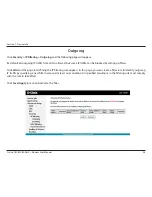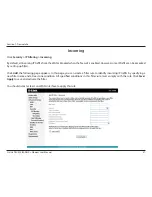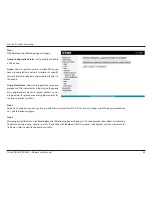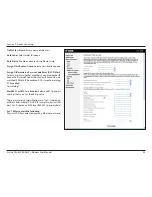
40
D-Link DSL-520B ADSL2+ Modem User Manual
Section 7 - Device Info
Using port forwarding (the forwarding of requests to particular ports), the router is forced to send requests from the Internet
for a certain service, for example, a game, to the appropriate port(s) on the PC on which the game is running. Port triggering
is a special variant of port forwarding. Unlike port forwarding, the DSL router forwards the data from the port block to the PC
which has previously sent data to the Internet via a certain port (trigger port). This means that approval for the data transfer
is not tied to one specific PC in the network, but rather to the port numbers of the required Internet service.
Where configuration is concerned, you must define a so-called trigger port for the application and also the protocol (TCP or
UDP) that this port uses. You then assign the public ports that are to be opened for the application to this trigger port. The
router checks all outgoing data for the port number and protocol. If it identifies a match of port and protocol for a defined
trigger port, then it opens the assigned public ports and notes the IP address of the PC that sent the data. If data comes back
from the Internet via one of these public ports, the router allows it to pass through and directs it to the appropriate PC. A trigger
event always comes from a PC within the local network. If a trigger port is addressed from outside, the router simply ignores it.
Note:
• An application that is configured for port triggering can only be run by one user in the local network at a time.
• After public ports are opened, they can be used by unauthorized persons to gain access to a PC in the local network.
• When the DSL router is supplied, the NAT function is activated. For example, all IP addresses of PCs in the local network are converted
to the public IP address of the router when accessing the Internet. You can use NAT settings to configure the DSL router to carry out
the following tasks.
• For functions described as follows, IP addresses of the PCs must remain unchanged. If the IP addresses of the PCs are assigned via
the DHCP server of the DSL router, you must disable DHCP server as the settings in the local network menu entry for the lease time
or assign static IP addresses for the PCs.
• You can enable or disable the NAT function. By default, the NAT function is enabled.
Содержание DSL-520B
Страница 1: ......
















































